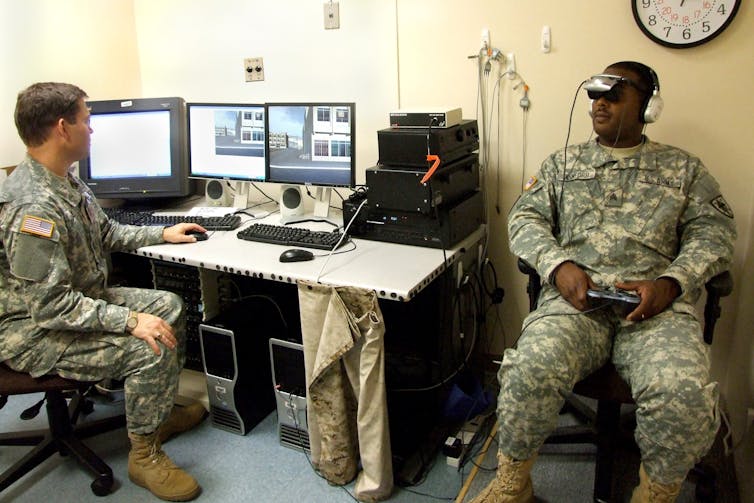What could once only be imagined in science fiction is now increasingly coming to fruition: Drones can be flown by human brains’ thoughts. Pharmaceuticals can help soldiers forget traumatic experiences or produce feelings of trust to encourage confession in interrogation. DARPA-funded research is working on everything from implanting brain chips to “neural dust” in an effort to alleviate the effects of traumatic experience in war. Invisible microwave beams produced by military contractors and tested on U.S. prisoners can produce the sensation of burning at a distance.
What all these techniques and technologies have in common is that they’re recent neuroscientific breakthroughs propelled by military research within a broader context of rapid neuroscientific development, driven by massive government-funded projects in both America and the European Union. Even while much about the brain remains mysterious, this research has contributed to the rapid and startling development of neuroscientific technology.
And while we might marvel at these developments, it is also undeniably true that this state of affairs raises significant ethical questions. What is the proper role – if any – of neuroscience in national defense or war efforts? My research addresses these questions in the broader context of looking at how international relations, and specifically warfare, are shaped by scientific and medical expertise and technology.
Weaponization of a peaceable science?
To understand the relationship between science and war, academic bioethicists, journalists and policy advisors alike typically rely on the framework of “dual use.” Starting from the assumption that the purpose of science is to improve human life, this perspective nevertheless admits that many technologies used in peacetime or to help enhance human capacities can also be harnessed to a second use: harming and degrading human capacities as part of a military arsenal. This framework calls attention to the potential misappropriation of sciences and technologies. By acknowledging potential misuses, it aims to help guide policy to limit such possibilities through practical tools such as weapons conventions.
Key to this framework is the concept of “weaponization.” The dual use idea assumes that we should be concerned with how a once “peaceful” science or technology came to be developed and used in war or national security applications. This process is termed the “weaponization of neuroscience.”
The dual use framework and the weaponization concept may offer some immediate potential practical utility. But, as I have written more extensively elsewhere, they’re based on a massively misguided notion both of the history of neuroscience and of what is at stake practically and politically.
Neuroscience’s roots are both civilian and military
The dual use framework and weaponization concept assume stark war/peace and military/civilian divides. But in fact, the discipline of neuroscience grew equally and simultaneously out of institutions we typically consider civilian and military.

Modern neuroscience was established in the post-WWII period. Like many disciplines developed and funded in that era (such as physics, nuclear medicine and others), the discipline was established through military funding in both “civilian” institutions such as MIT and Harvard and military research institutes such as the Walter Reed Army Institute of Research. That Institute’s Department of Neuropsychiatry originated the idea that researchers should study brain anatomy and physiology at the same time as psychology or psychiatry. Neuroscience was funded and shaped to meet the needs of warfare and national security imperatives.
This state of affairs was nothing new: Modern warfare and medical and scientific innovation have long been symbiotic, including the “invention” of American clinical neurology through the American Civil War. It’s not possible to say that neuroscience has been “weaponized,” because this presumes a naturally peaceful and nonmilitary origin story that is simply historically inaccurate.
Simultaneously used for good and ill
Also, the dual use framework and the concept of weaponization assume a distinct divide between help and harm. People using these concepts are primarily concerned with harmful applications of neuroscience – those that degrade human capacities. Without a doubt, these are of deep concern. Few would deny that we should pay close attention, for instance, to the use of neuropharmaceuticals to degrade the combat capabilities of enemies or produce interrogation susceptibility, or related developments.
But the stark divide between help and harm elides the fact that many technologies can do both simultaneously.
One example is the current DARPA-funded development of brain-machine interfaces. These technologies seek to connect the brain directly to machine technologies in order to control them remotely. Of course this may be a boon for veterans and soldiers in need of better prosthetic devices. But these are the very same technologies (and sometimes the same experimental subjects) that are being used to pilot drones for potential use in warfare.

By way of a second example, consider military medical and rehabilitative practices. These are assumed to be on the “help” rather than “harm” side of the split. Think, for instance, of increasing diagnosis of (mild) traumatic brain injuries in military settings. Treatment of these injuries may do great good in the clinical setting for individuals who receive this care. But these therapies are also part of a system of military medicine aimed at producing war readiness and potential redeployment of soldiers. The good health of soldiers (help) is integral to warfare (harm), suggesting that the help/harm divide is not so stark as the dual use framework assumes.
For all these reasons, it’s not possible to say that neuroscience has been “militarized” or “weaponized.” The dual use framework ignores how embedded neuroscience has always been with war and national defense. In doing so, it leads us to underestimate the political task at hand, both in relation to war and in relation to science. On the side of war, it elides the ethical questions we need to be asking, not only about weaponization, but also about the supposedly benign practices of diagnosis, cure and enhancement. On the side of science, it obscures questions about what research gets funded and praised, and about the opportunity costs of allowing military imperatives to drive scientific inquiry.

